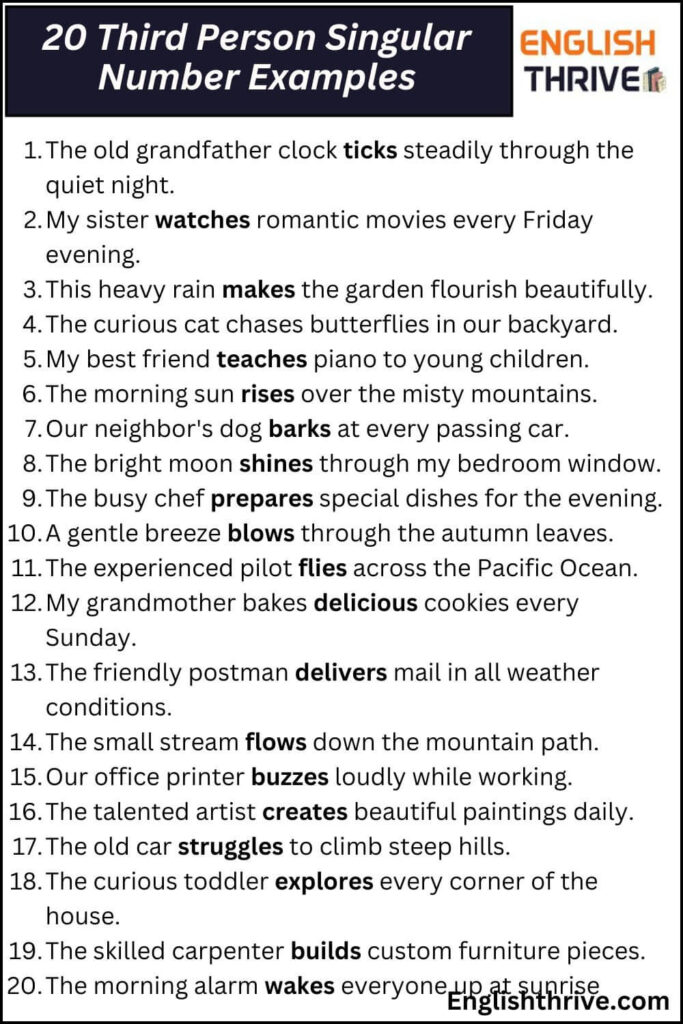Have you ever wondered why we say “He runs” instead of “He run”?That little “s” may look simple, but it plays a powerful role in English grammar.Understanding the Third Person Singular Number helps you speak and write correctly, especially when forming sentences in the present simple tense.
In this guide, we’ll explain what it means, how to use it correctly, and how to avoid the most common mistakes — with charts, examples, and quick tips to make learning easy and fun.
Contents
ToggleWhat Is the Third Person Singular Number?
The Third Person Singular Number refers to a subject that represents one person, animal, or thing other than the speaker or the listener.
It’s used with pronouns like he, she, it or singular nouns like John, the dog, or the computer.
Rule in Simple Terms
When the subject is in the third person singular, the main verb in the present simple tense usually takes an “-s” or “-es” ending.
Example:
| Subject | Base Verb | Third Person Singular | Example Sentence |
|---|---|---|---|
| He | run | runs | He runs every morning. |
| She | walk | walks | She walks to work. |
| It | rain | rains | It rains heavily in summer. |
| The cat | sleep | sleeps | The cat sleeps all day. |
Remember: This rule applies only in the present simple tense, not in past or future tenses.
How to Form the Third Person Singular
Here’s how verbs change when used with a third person singular subject:
1. Regular Verbs
Simply add –s to most base verbs.
Example:
play → plays,
read → reads,
eat → eats
2. Verbs Ending in –sh, –ch, –x, –z, or –s
Add –es to make pronunciation smoother.
| Base Form | Third Person Singular | Example |
|---|---|---|
| push | pushes | He pushes the cart. |
| wash | washes | She washes her clothes. |
| fix | fixes | He fixes computers. |
| buzz | buzzes | The bee buzzes loudly. |
| watch | watches | She watches TV daily. |
3. Verbs Ending in Consonant + y
Change the “y” → “i” and add –es.
| Base Form | Third Person Singular | Example |
|---|---|---|
| cry | cries | The baby cries loudly. |
| study | studies | He studies English daily. |
| fly | flies | The bird flies high. |
4. Verbs Ending in Vowel + y
Simply add –s (no spelling change).
| Base Form | Third Person Singular | Example |
|---|---|---|
| play | plays | She plays piano beautifully. |
| say | says | He says funny things. |
5. Irregular Verbs
Some verbs don’t follow the normal rules.
| Base Form | Third Person Singular | Example |
|---|---|---|
| have | has | It has four legs. |
| do | does | He does homework daily. |
| go | goes | She goes to school early. |
| be | is | The car is fast. |
Common Exceptions
Certain verbs never change form, even in the third person.
| Verb Type | Example | Explanation |
|---|---|---|
| Modal Verbs | can, will, must | No change – “She can dance.” |
| Auxiliary Verbs | have, do | Take their own changes (“He does work.”) |
| Verb “be” | am, is, are | Unique changes (“She is happy.”) |
Common Mistakes with the Third Person Singular
1. Forgetting the “s” or “es”
❌ He walk to school.
✅ He walks to school.
2. Adding “s” to irregular forms incorrectly
❌ He haves a car.
✅ He has a car.
3. Using the rule in past tense
❌ He walkeds yesterday.
✅ He walked yesterday. (No “s” in past tense!)
Why We Add “s” in the Third Person Singular
The “s” ending is more than just a rule — it’s part of English history.
It evolved from Old English to make it easier for listeners to identify who is performing the action.
This pattern helps maintain clarity and rhythm in speech, marking subject-verb agreement clearly.
How to Use the Third Person Singular in Questions and Negatives
When making questions or negatives in the present simple, we use “does” for the third person singular and return the main verb to its base form.
Examples:
- ❓ Does he play football?
- ❌ He doesn’t plays football.
- ✅ He doesn’t play football.
💡 Tip: “Does” already contains the third person “s,” so the main verb stays simple!
Practice: Quick Mini Quiz
Choose the correct form of the verb.
- She (like / likes) coffee.
- He (go / goes) to work by bus.
- The baby (cry / cries) every night.
- It (rain / rains) a lot in April.
- The student (study / studies) hard.
Answers:
- likes
- goes
- cries
- rains
- studies
Helpful Tips for Mastery
Tip 1: Always check your subject — if it’s he, she, it, or a singular noun, add –s / –es.
Tip 2: Remember that do → does and have → has are irregular forms.
Tip 3: Don’t apply the rule in past tense or with modal verbs.
Tip 4: Read aloud to hear if your sentence “sounds right.” Listening improves accuracy.
Common Third Person Singular Verbs
| Subject | Base Verb | Third Person Singular | Example Sentence |
|---|---|---|---|
| He | work | works | He works at a bank. |
| She | dance | dances | She dances gracefully. |
| It | rain | rains | It rains in spring. |
| The teacher | teach | teaches | The teacher teaches English. |
| The car | start | starts | The car starts quickly. |
| The computer | crash | crashes | The computer crashes often. |
| The bird | fly | flies | The bird flies south. |
| Mary | cook | cooks | Mary cooks dinner. |
Third Person Singular in Different Context
Here are some natural sentences using the rule correctly:
- The sun rises in the east.
- My friend teaches guitar on weekends.
- The wind blows softly through the trees.
- Our cat sleeps near the window.
- The phone rings every morning at 9.
FAQs About the Third Person Singular Number
1. Why do we add “s” or “es” in the third person singular?
To show agreement between the subject and the verb. It helps identify who performs the action.
2. Does this rule apply in other tenses?
No. It applies only in the present simple tense. In other tenses, verbs change differently (e.g., walked, will walk).
3. How do I know when to add “es”?
Add “es” if the verb ends with sh, ch, s, x, or z (e.g., washes, fixes, buzzes).
4. What happens in questions or negatives?
Use “does” with the base verb. Example: Does he play? / He doesn’t play.
5. How can I remember this rule easily?
Think: “If it’s he, she, or it, then add s to fit.”
Conclusion
Mastering the Third Person Singular Number may seem small, but it’s a vital step in sounding natural and confident in English.
With practice, the rule becomes automatic — helping you write and speak more fluently.
Keep reviewing examples, practice with friends, and soon you’ll use this grammar rule without even thinking about it!


